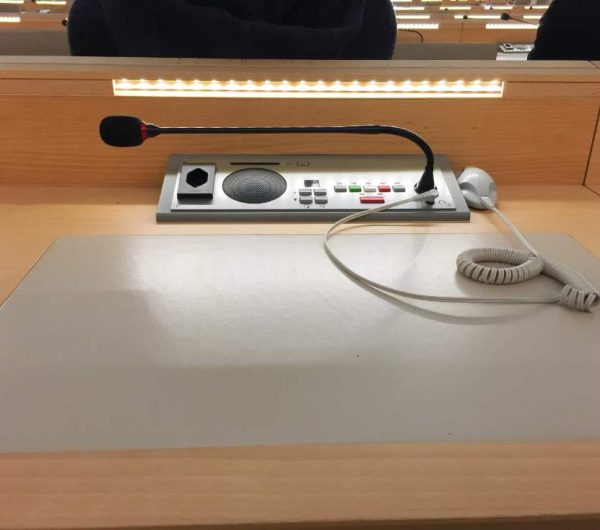Simultaneous interpreting for international events
SIMULTANEOUS INTERPRETER
Basically, a distinction must be made between these types of interpreting:
1.
Simultaneous interpreting / simultaneous interpreters
2.
Consecutive interpreting / consecutive interpreters
In consecutive interpreting, the translation is provided with a delay after the original speech. Consecutive interpreting is the appropriate form of interpretation for relatively short speeches (e.g. table talks) or negotiations where the presence of the interpreter in the negotiation room is required. In consecutive interpreting, the duration of the event is roughly doubled per target language compared to simultaneous interpreting.
3.
Whispered interpreting / whispered interpreters
In whispered interpreting, the interpreter speaks at the same time as the speaker but does not use any special technical equipment. Whispered interpreting is suitable for very small groups, such as factory tours, but cannot replace simultaneous interpreting, as the original speaker and interpreter speak simultaneously in the same room, thus creating unavoidable distractions. Since whispered interpreting requires the same or greater concentration than simultaneous interpreting, two interpreters per target language are also required for longer events.
4.
Liaison interpreting / liaison interpreter
In negotiation interpreting, shorter text passages are translated with a delay and in segments during conversation situations into another language.

Hire conference interpreters
Planning the interpreting assignment
A consulting interpreter should be involved in the planning of an international event as early as possible.
They can advise the organizer on the planned event schedule from an interpreting perspective
and, if necessary, help prevent unnecessary costs from arising at this stage.
Conference interpreters should be hired as early as possible (possibly several weeks before an event).
Since the number of qualified interpreters in Germany is limited, bottlenecks often occur during conference-heavy months in spring and autumn,
or for rare languages.
For events with simultaneous interpreting, the number of interpreters required and the composition of the team depend on the number of conference languages,
the number of parallel sessions, the duration of the sessions, and the complexity of the topic.
Interpreter teams should be organized in such a way that all languages can be directly interpreted into all target languages,
and interpreters do not have to interpret a previously translated text into another language indirectly (via relay).

Interpreting and conference technology
Interpreting equipment must comply with ISO/DIS 2603 (for fixed booths) or 4043 (for portable booths).
The conference technology must meet the ENV standard 50185-1 or the CEI standard 914.
The booths should be arranged so that the interpreters have a good view of the speakers and all projection screens. The speaker's gestures and facial expressions, as well as any images projected, are just as important for the interpreter as they are for the listener. Screens or monitors are at best a visual supplement, but not a substitute for direct vision.
Films and similar presentations can only be interpreted if the interpreter has seen the script before the event and the sound is transmitted perfectly into the booth.
For copyright reasons, recording interpreted texts generally requires the prior consent of the interpreters and is generally not part of the contracts concluded with the interpreters.
The preparation of the event
Interpreters must prepare for the specific topics of the event. To do this, they need background material such as information about the organizer and other participating organizations, the program, agenda, possibly minutes of previous events, the schedule, and generally all documentation available to participants.
Participant lists and, where available, terminology databases, for example with the official translations of names and bodies of organizations, should also be available to the interpreters before the event.
To the extent that speeches and discussion contributions are prepared in writing by the speakers, they should be made available to the interpreters for familiarization.
It is sometimes also advisable to brief the interpreters beforehand and have them participate in speaker meetings.
Conference interpreters are obliged to treat all information confidentially.
Speaker
Speakers should be encouraged by the event organizer to submit their manuscripts as early as possible, but no later than two weeks before the event, for distribution to the interpreters. It is helpful to indicate on the script whether it is a final spoken version, a draft, or whether the speaker intends to speak extemporaneously. Significant changes to spoken texts should be communicated to the interpreters at the venue. Regardless of whether a speaker speaks extemporaneously or reads from a text, an appropriate speaking pace is important. For texts interpreted from English into German, for example, the interpreted version is often longer than the original and requires more time. Eye contact between speaker and interpreter is beneficial.
Simultaneous interpreting is only possible if the speakers speak into a switched-on microphone, as simultaneous interpreting booths are soundproof. Speakers who move away from the lectern during their presentation should use a lapel microphone. The organizer should ensure that a person in the hall is specifically responsible for ensuring that the technical equipment is functioning properly.
Numbers and proper nouns should be pronounced particularly clearly. Abbreviations should be avoided, or at least explained when they first appear. Quotations, proverbs, and puns can lighten up a speech, but are often difficult to translate into another language.


